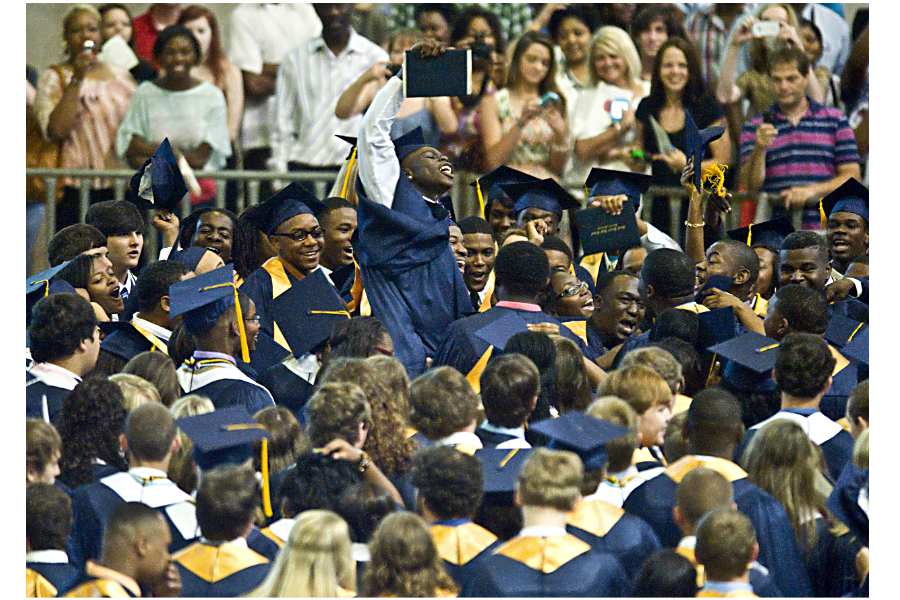As college prices soar, poorest students fall further behind
Loading...
Hundreds of food pantries cropping up on college campuses offer one stark symbol of the gulf between the experiences of rich and poor as they reach for the American dream.
It symbolizes a fundamental challenge facing US families: Even as students from all income backgrounds agree they need it, higher education is getting harder and harder to afford.
In fact, one newly released study suggests the gap in college attainment between students at the top and bottom of the income scale has been widening.
That’s not just a problem for low- and moderate-income students. It’s also a serious problem for America’s whole economy, education researchers say. That’s because the nation needs to replace retiring baby boomers and fill future jobs with a well-educated workforce.
“There is good progress in high school graduation and college [entry] for low-income kids. Then these enormous financial barriers … just clobber them when they get to college,” says Tom Mortenson, a senior scholar at The Pell Institute for the Study of Opportunity in Higher Education in Washington. “Median family income has been declining at the same time that real college attendance costs have been going up steadily.”
The gap in college completion is huge. Among students who are still dependent on their parents, for instance, 77 percent of those in the top half of the income scale are obtaining a bachelor’s degree by age 24, according to data for 2014. But in the bottom half of the income spectrum, only 23 percent are getting degrees.
And that chasm is even wider than it used to be. In 1970, it was 72 percent of those top-half students and 28 percent of the bottom-half students who were getting degrees.
Those figures come from a new report on equity by The Pell Institute, which has tracked the issue for years and recently revised and expanded its methods of data analysis in partnership with the University of Pennsylvania Alliance of Higher Education and Democracy.
This study isn’t the only one that has found the divide to have grown over the long haul. Susan Dynarski at the University of Michigan has researched the college-completion gap between the students from the highest- and lowest-income quartiles of the population. The gap between those groups was about 45 percentage points for students born in the 1970s and early 1980s, up from about 30 percentage points for those born in the early 1960s.
One key reason for the gap is a decline in college affordability.
States like to tout the low cost of tuition at two-year community colleges and some public four-year universities. But even after students receive financial aid, the real cost for tuition plus fees, textbooks, and various living expenses to attend many community colleges would require low-income students to work more than 20 hours a week – a factor correlated with much higher dropout rates.
Mapping affordability gaps
“If current trends continue … it’s likely that we’ll see even more stratification, not only within colleges and universities, but then within society,” notes Joni Finney, co-author of a new report focused on college affordability.
Her research takes the various costs into account and compares them with family incomes across America. It finds that only 15 states improved the affordability of public two-year colleges between 2008 and 2013; only six states improved affordability at public four-year schools.
An interactive map accompanying the report shows how affordability varies among the states – and also allows comparison of neighborhoods within states.
Many families earning less than $30,000 are already living on debt to meet basic expenses. But in the 15 states with the highest percentage of such families, students would have to pay 41 to 73 percent of family income to attend a four-year public non-doctoral university, notes the report, called the College Affordability Diagnosis, by the Institute for Research on Higher Education at the University of Pennsylvania Graduate School of Education.
Ms. Finney sees a risk “that people will lose hope in their future because opportunity seems so out of reach for them…. We’ll see a collision of economics, race, and politics around this.”
Calls for free or debt-free college have been popular on the campaign trail during the Democratic presidential primary race. But even if that wish were to come true, it wouldn’t completely wipe out the disparities.
Even for students who can get expenses covered, other factors are at play, everything from the type of preparation and counseling students get in high school to the level of advising students access once they are on a college campus.
“In places that have made college free for low-income kids, you still see big gaps in the [college entry] and graduation rates of low-income versus high-income kids,” Professor Dynarski says.
Seeking solutions
College Possible, an AmeriCorps organization, is an example of how some groups are striving to make a difference. It pairs low-income high school students (most of whom are the first generation in their families to go to college) with recent college graduate coaches. They help the students work through admissions and financial aid, but also any hurdles they face once they enroll in college – whether it’s culture shock or bureaucratic roadblocks.
A randomized study – the gold standard for evaluations – found that students in the program were 15 percentage points more likely than their peers to enroll in a four-year college.
Once in college, 55 percent of College Possible students earn a bachelor’s degree within six years, according to the group’s tracking. That compares with a national average of about 11 percent of low-income, first-generation college students as tracked by The Pell Institute.
College Possible serves about 20,000 students a year and is expanding.
To address the growing problem of hunger (experienced by 1 out of 5 community-college students in one survey), the Wisconsin Hope Lab at the University of Wisconsin this week proposed an expansion of the federally funded school lunch program to college students.








